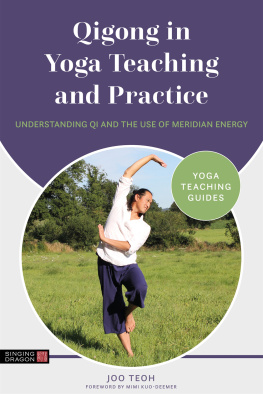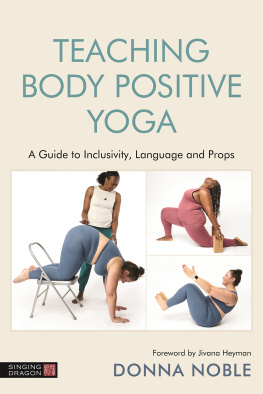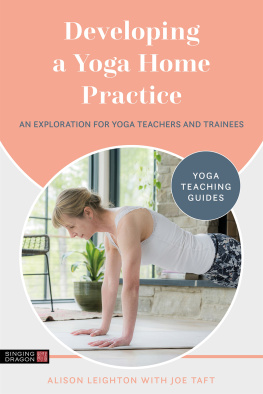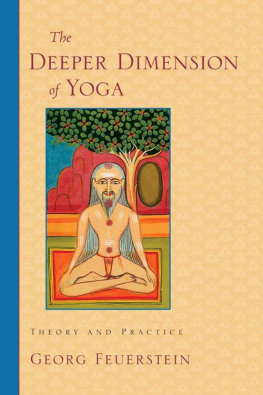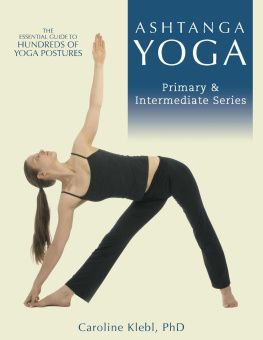Contents

QIGONG IN YOGA
TEACHING AND
PRACTICE
Understanding Qi and the
Use of Meridian Energy

Joo Teoh
Foreword by Mimi Kuo-Deemer
Series Editor: Sian ONeill

CONTENTS
FOREWORD
I first met Joo in a yoga studio in Beijing, China in 2006. He had come to take class at Yoga Yard, a studio founded by myself and a fellow American, Robyn Wexler. It did not take long before Joo became one of the studios most beloved teachers, as well as an enduring friend. He taught what many teachers at Yoga Yard drew on: yoga influenced by qigong and theories underlying Chinese medicine. Qigong in Yoga Teaching and Practice is the accumulated experience of Joos more than 15 years of study, exploration and dedication to two rich and evolving traditions of yoga and qigong.
While most people in the world today have been exposed to yoga and know what it is, far fewer have come across qigong. The reasons for this are layered. One reason is the relatively limited exchange of ideas between China and the West especially compared with that which took place between India and the West. With Indias steady ties to Britain in its colonial and postcolonial eras, exchange flourished, whereas in the wake of Chinas civil wars and victory of Chairman Maos Chinese Communist Party in 1949, China closed itself off to the outside. It was not until economic reforms began in 1979 that a growing number of Chinas cultural traditions, from Classical Chinese Medicine to martial arts, started to flow into the mainstream of Western society. A second reason has to do with yogas more successful worldwide marketing compared with qigong: think of slim, youthful images of people in a yoga handstand at the beach, versus someone pictured standing in qigongs foundational posture, Wuji , with their arms rounded in front of their chest, clad in baggy silk pyjamas! And finally, qigong is like moving meditation: practices tend to be slower and rarely induce a sweat. Like any approach to Chinese medicine, it works gradually, creating deeper, lasting shifts in our organ and meridian systems. Anything that takes time and patience is a harder sell in our modern world, where people strive to express mail themselves across the finish line to a healthier, happier life.
Fortunately, times are changing. More people today are discovering qigongs subtle yet powerful and transformative ability to rebalance energy and foster vibrant health. Among many yoga teachers and dedicated students, interest in qigong has blossomed into a particularly strong affinity. This comes as no surprise, especially given the popularity of Yin Yoga and an ever-growing number of yoga teacher trainings that include approaches to how Traditional Chinese Medicine can be applied to yoga practice. Rather than diluting the tradition, I believe this integrative approach expands and enriches the experience and embodiment of yoga. Also, a yoga practice imbued with qigongs imagery of the natural world can impact the way we experience and relate to our environment. The emphasis on observing and learning about natures balance and harmony in qigong comes at a time when our species and the fate of our planet face a dire and ecologically disastrous future. We are part of nature manifest in human form. When we recognise this, we start to see that when we take care of ourselves, we are taking care of our planet.
Yoga and qigong are living traditions that continually evolve and grow. When we attempt to keep traditions from changing and cling to a sense of ownership, we start to erect boundaries and strict ideas of right and wrong. This is a human tendency. Yet, if one definition of yoga is the expansion of consciousness and a path to liberation, or moka , then the orientation and evolution of practice can also be seen as what liberates us from rigid beliefs and narrowing, confining orthodoxies.
In the world we inhabit today, attempts to prove accuracy over fallacy have polarised our political as well as social realms to the point where basic rights and freedoms are endangered. Any willingness to bridge and build commonality between cultures and practices comes as a relief. By bringing together yoga and qigong, yoga teachers and students can not only gain new insights into how they approach their practice and health, but also discover ways to inject positive value and innovation into the inevitable dialectic of change.
As an acupuncturist, yoga teacher and qigong teacher, Joo is a pioneer at the frontier of an exciting and evolving point in history where ancient traditions can meld together. In this unique book with an equally unique voice, he grants a refreshing space to his readers to explore, adapt and reshape the way we can structure and approach yoga and qigong. Part of his ability to share this progressive approach stems from his ability to defy conventional definitions of culture and identity. As an ethnically Chinese man who grew up in Malaysia, was schooled in the UK and lived and worked in the US and China, he is uniquely positioned to move between cultures and fuse the best of them together. As a trained acupuncturist, he also offers a deeper understanding of the theories behind Chinese medicines laws of association, balance and treatment.
Qigong in Yoga Teaching and Practice is a book that navigates two ancient systems of mental, physical and spiritual discipline beautifully. It offers a rich resource and guide into the theories behind Chinese medicine that underlie qigong forms, as well as practical examples of class themes and sequences based on the Chinese Five Elements to get you started. Whether you are a yoga teacher interested in deepening your understanding of Chinese medicine, or a teacher keen to start mixing qigong forms into your yoga asana classes, this book will offer you a treasure trove of insights and possibilities to grow your practice, teaching and love of yoga.
Mimi Kuo-Deemer, author of
Qigong and the Tai Chi Axis and Xiu Yang
PREFACE
In 2006, while living in Beijing, I hit a plateau in my yoga practice. I was doing strong 90-minute vinyasa classes four or five times a week, and instead of feeling energised, I felt drained by the practice. I spoke to my teacher at the time, Mimi, who suggested that I attend some workshops with a teacher visiting from Los Angeles. His name is Matthew and he does this cool thing where he mixes tai chi and yoga, Mimi told me. Not only did I do four of his workshops, I also found myself on my first teacher training course with Matthew Raymond Cohen a few months later. That year, I also met Cameron Tukapua, a wise woman and experienced healer, an acupuncturist, founder of Christchurch College of Holistic Healing and teacher of Traditional Chinese Medicine. She revealed to me a much deeper understanding of the Five Elements, which in turn led to my study with Gerad Kite, founder of the London Institute of Five Element Acupuncture. Along with Mimi, Matthew, Cameron and Gerad, I am very grateful and fortunate to also call Max Strom and Judith Hanson Lasater my teachers. Their honesty, their humour, their knowledge and their humanity still guide the way I teach and practise today.
Since incorporating qigong into my daily life and yoga practice, my physical practice no longer exhausts me. I believe deeply in the healing potential of blending yoga and qigong. It is what I practise, and it is what I have been teaching since 2007. My practice consists of clear intention, strong breath, flowing movement and conscious rest. The exercises are drawn from yoga asana, pranayama , mudra, mantra, Daoist teachings, Chinese medicine and acupuncture, qigong and the Five Elements. In this book I want to inspire you to explore the practice of qigong and to incorporate its principles, exercises and themes into your yoga.

